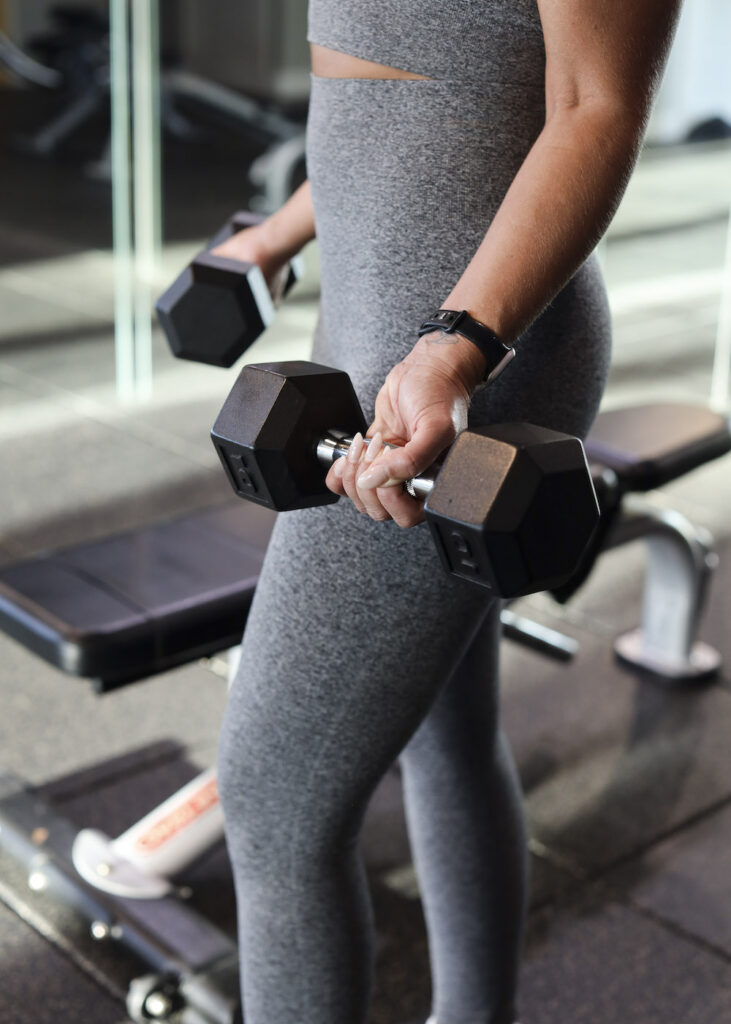
Strength training: Why women in their 40s need to start now
When you lift weights, magic happens. At least, that’s what it feels like for me. It doesn’t occur overnight — in about three months from personal experience — but reaching for a 20-pound dumbbell instead of a five feels like proven success. Not to mention the confidence of knowing that I’m doing what I can to prepare my body for a healthy future.
Always needing the why more than the how, I researched strength training facts for women in their 40s to get my glutes in gear during a recent lull. What I found not only motivated me, it scared me straight to the gym. See for yourself why we women need to start strength training — yesterday:
Women’s weights and workouts: Facts don’t lie
Get this: More than 60 percent of women in the US don’t engage in the recommended amount of physical activity, according to the Centers for Disease Control and Prevention (CDC). Yikes. We sound pretty lazy — or busy, or both — to deprioritize our health if we’re able-bodied to work out.
This recommended amount, according to the Physical Activity Guidelines for Americans, is a mere 150 minutes of “moderate-intensity activity” each week. While that may seem achievable when tracking steps or activity rings or even really working out, here’s the clincher: We also require two days of muscle-strengthening activity. If that corner of the gym intimidates you, too, know there’s much more than bench-pressing we can do: Strength training is really any exercise that causes your muscles to contract against an outside resistance, which can be from your own body weight, weight machines, medicine balls, resistance bands, or dumbbells. But why sweat it?

Women’s muscles and maturing: Reversing the years
Have you heard of “sarcopenia?” (Me neither, until now.) Sarcopenia refers to the progressive loss of muscle mass and strength naturally caused by getting older. This decrease in the number and size of muscle fibers can just — happen. According to the Cleveland Clinic, as we add on years, our bodies produce lesser amounts of the proteins that muscles need to grow, causing our muscle cells to get smaller. In fact, muscle mass decreases approximately 3–8% per decade after the age of 30. Now do the math.
Changes in certain hormones, specifically testosterone, can also lead to muscle loss as we age. Still, the relationship between women’s hormones and muscle mass strangely remains less understood. What we know: Muscle mass is not affected by a decrease in estrogen. What we think: Researchers instead think that other symptoms surrounding perimenopause and menopause may exacerbate muscle loss, including increased body fat, less energy, sleep disruption, mood and motivational changes, and unexpected injury.
Everybody can experience this involuntary muscle mass decrease as they age, but the awesome news is that this loss (which can be interpreted as a loss of function and freedom as well) can be prevented and even reversed.
Women’s bones and breaks: Prevention is key
When we enter perimenopause, the drop in our estrogen levels can cause bone loss. To be specific, we women lose up to 10 percent of bone mass in the first five years after menopause. Even scarier, if our bone mass before this age is less than ideal, any bone loss around menopause may result in osteoporosis — a bone disease that develops when bone mineral density and bone mass decrease, leading to fractures.
Many experts call osteoporosis a “silent disease” since no symptoms typically occur until a bone is broken. Fortunately, like our muscles, we can also be proactive to strengthen and protect our bones. According to Harvard Health, numerous studies have shown that strength training can help to slow bone loss and even build bone to offset age-related declines in bone mass.
While a broken bone and bottle of Ensure may seem years away, know that osteoporosis is responsible for more than 2 million fractures each year, with hip fractures being the most serious. And here’s the kicker: Six out of 10 people who break a hip never fully regain their former level of independence. Even walking across a room without help may become impossible. Prevention with strength training and other healthy choices like eating a diet rich in calcium is key.

More benefits of strength training for women
Inspired to start (or continue) strength training yet? Beyond the recommended two days per week, experts advise that you can increase your muscle-building days to four as you advance, with restorative rest days in between workouts. When done correctly, this dedicated weight resistance schedule can provide even more incredible results:
Increased metabolism, decreased fat
Strength training burns body fat and builds lean muscle mass. This means your body burns more energy as you become stronger — even at rest. According to a recent study, your metabolism stays elevated for up to 38 hours after a strength training session.
Boosted mood and body image
Lifting can boost your mood in many ways. Simply creating a schedule and sticking to healthy habits makes you feel good about yourself. Moreso, strength training can help reduce symptoms of depression — all while improving self-confidence, building self-esteem, and improving the way you feel about your body.
Better brain functioning
A long-term study found that strength training improves our cognitive performance, specifically benefiting the hippocampus region in our brains, which is responsible for learning and memory. Digging deeper, researchers found that strength training targeted the subregions in the hippocampus affected by Alzheimer’s disease, clearly benefiting its prevention, along with dementia.
Improved sleep quality
We’ve all heard that exercise helps us sleep better. But did you know that strength training, specifically, offers the most substantial results? Apparently, individuals who regularly completed resistance training slept better and longer than those who only opted for cardio.
Other benefits of strength training include improved posture and balance, along with easier management of chronic conditions and pain relief. Let’s not discount the bad-ass benefit of sexy biceps and folks doing double-takes when you lift something heavy with total confidence.
Getting started with building muscle for women
To be completely honest, getting started scared any last bit of cool out of me, and I felt like I had to workout to start working out! Not the case. Through friends’ recommendations, I found Orangetheory Fitness to meet my workout needs with half of the class dedicated to weight resistance — and trainers leading the classes to help you do it right. Of course hundreds of videos exist online to instruct you on form, technique, and timing. Still, always check with your healthcare professional to make sure your workouts are right for you.
For more tips on strength training during menopause, read “What it’s like for a former female bodybuilder to lift weights after menopause” by Dixie Laite.
This article is dedicated to my girlfriends Alison and Kim (second photo, right), who inspire me to work out with their soft encouragement and strong example.



